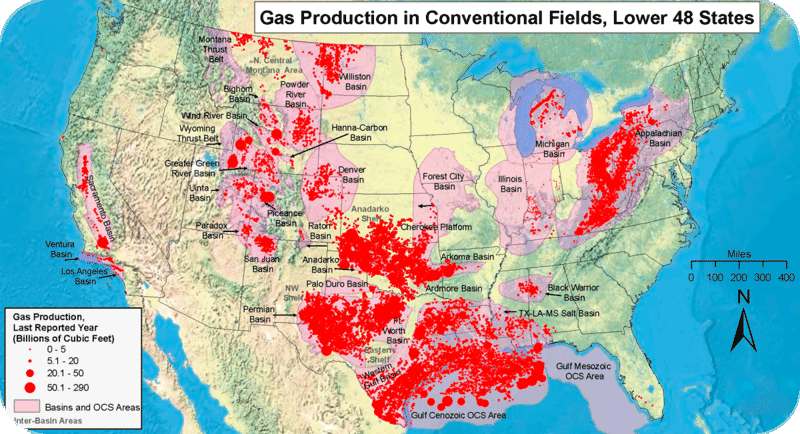
The process of extracting natural gas, known as fracking, injects liquid waste into deep wells. Coincidentally, locations where seismic activity is virtually unknown have begun to experience earthquakes. Is fracking related to earthquake activity? Many geologists think the link is undeniable.
Natural Gas
Natural gas, often known simply as gas, is composed mostly of the hydrocarbon methane. The amount of natural gas being extracted and used in the Untied States is increasing rapidly.
Natural Gas Formation
Natural gas forms under the same conditions that create oil. Organic material buried in the sediments harden to become a shale formation that is the source of the gas. Although natural gas forms at higher temperatures than crude oil, the two are often found together.
The largest natural gas reserves in the United States are in the Appalachian Basin, North Dakota and Montana, Texas, and the Gulf of Mexico region (Figure below). California also has natural gas, found mostly in the Central Valley. In the northern Sacramento Valley and the Sacramento Delta, a sediment-filled trough formed along a locationwhere crust was pushed together (an ancient convergent margin)."

Gas production in the lower 48 United States.
Natural Gas Use
Like crude oil, natural gas must be processed before it can be used as a fuel. Some of the chemicals in unprocessed natural gas are poisonous to humans. Other chemicals, such as water, make the gas less useful as a fuel. Processing natural gas removes almost everything except the methane. Once the gas is processed, it is ready to be delivered and used. Natural gas is delivered to homes for uses such as cooking and heating. Like coal and oil, natural gas is also burned to generate heat for powering turbines. The spinning turbines turn generators, and the generators create electricity.
Consequences of Natural Gas Use
Natural gas burns much cleaner than other fossilfuels, meaning that it causes less air pollution. Natural gas also produces less carbon dioxide than other fossil fuels do for the same amount of energy, so its global warming effects are less (Figure below).

A natural gas drill rig in Texas.
Unfortunately, drilling for natural gas can be environmentally destructive. One technique used is hydraulic fracturing, also called fracking, which increases the rate of recovery of natural gas. Fluids are pumped through a borehole to create fractures in the reservoir rock that contains the natural gas. Material is added to the fluid to prevent the fractures from closing. The damage comes primarily from chemicals in the fracturing fluids. Chemicals that have been found in the fluids may be carcinogens (cancer-causing), radioactive materials, or endocrine disruptors, which interrupt hormones in the bodies of humans and animals. The fluids may get into groundwater or may runoff into streams and other surface waters. As noted above, fracking may cause earthquakes.
Summary
Natural gas forms with crude oil but at higher temperatures.
Natural gas burns more cleanly than petroleum and produces fewer greenhouse gases.
Hydraulic fracturing, known as fracking, is a relatively new method for extracting natural gas, which may be linked to groundwatercontamination and the generation of small earthquakes in non-seismic regions.


No comments:
Post a Comment